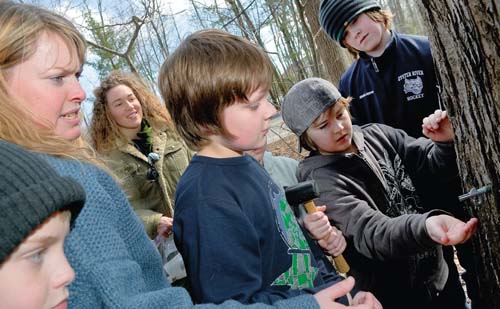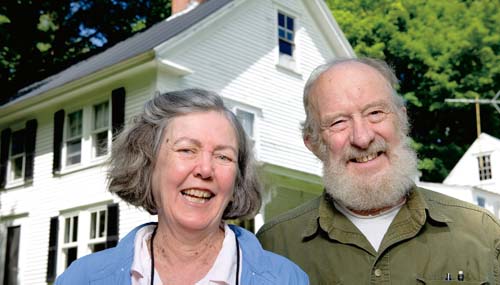 |
 |
| current issue |  | past issues |  | send a letter/news |  | address update |  | advertise |  | about us |  | alumni home |
Features
The QuestPage 3 of 3
Studying maple sap to understand tree health is new territory. While some researchers are studying phenolic compounds in syrup in order to explore the potential health benefits to humans, few have concentrated on the sap itself and its implications for the health of the tree. "We're looking at phenolic compounds in terms of the plant's defense system," says Brady. "But we're a long way from having any data to report." The process is labor intensive—Brady sometimes spends nine hours a day running samples. "Just developing a dependable method, and trying to make sure you can reproduce the results, is not easy." Even small variations in experimental conditions have the potential to skew the data. "And the concentrations we're dealing with are so low," she says, "it requires an extra-sensitive method."
 Lisa Nugent/UNH Photographic Services ON TAP: Moharimet Elementary School teacher Sarah Larson-Dennen '98G, top left, collects sap samples with, from left, Jack Harrington, intern Erika House '10, '11G, Oscar Ingelfinger, Julian Crawley and Geoffrey Smith. |
Once the analysis is complete, there's no telling what it will show. "We're just one piece of the puzzle," says Tomellini, who points out that the trees could be exhibiting stress caused by insects or disease, rather than climate change. "We aren't drawing any conclusions—we're the data-producers," he says. "And when we're through, the data will go back to the plant pathologists to determine what the findings might indicate." Tomellini points out that whatever the findings, the value of the research lies partly in the process itself, which offers a great teaching tool for potential use by high school students. "We're not just in the business of testing samples," says Tomellini. "We're in the business of training students at all levels."
Carlson is philosophical about her ongoing search for explanations; she realizes that she's on a journey without a clear destination. But she's undaunted. When she was a teacher, she used to tell her students, "If you want to study something with all the answers, become a historian. Science, on the other hand, is all about questions." As she heads into the final stretch of her research, she finds herself with far more questions than answers: "We know we're onto something—we just don't know what yet."
Meanwhile, Carlson delights in the research journey itself. "The tools I get to use at UNH are high tech," she wrote, describing her discoveries with a scanning electron microscope in a letter to the Providence Journal. "At 342x, maple xylem cells look like the sacred niches where Buddhas once stood in Afghanistan." She rattles off a slew of courses she's enjoyed and she revels in the interdisciplinary makeup of her thesis committee: a professor of natural resources, two chemists, a plant physiologist, a forester and a philosopher. She sees this mix as proof that the problem she is tackling is widely relevant, as evidence of the "thousand invisible cords" described by one of her favorite naturalists, John Muir, who wrote, "When we try to pick out anything by itself, we find that it is bound fast by a thousand invisible cords that cannot be broken, to everything in the universe."
 Erin Gleason/UNH Photographic Services Martha '09G and Rudy Carlson |
In fact, the circuitous route of her journey may be one of the most relevant aspects of Carlson's research. Donning her teacher hat, she speaks often to groups of students. "I want to find simple measures of stress that can be used to figure out if a tree is in trouble," she says. But the scientific path, she points out, is seldom a direct one, which is why forest researchers need help. "I want to train a whole cadre of syrup producers, children, students and teachers to observe these things," says Carlson. "We need ordinary naturalists, people who go out and look at nature and observe changes." Already, Carlson is enlisting students to help, developing a Maple Watch pilot program with several schools in New Hampshire. "Kids want to help—they want to be part of the solution to environmental challenges," she says. "We need to give them hope."
On a brilliant blue day in March, a group of fourth-graders tramps through the woods outside Moharimet Elementary School in Madbury, N.H., metal buckets in hand. They follow their teacher along a short trail, heading out to check on "their" trees. Peering into the buckets hanging against the trunks, the students exclaim about the overflowing sap and swap full buckets for empty ones. They clamor to take a turn with the hand drill, creating holes in the trunk for new taps. When they are finished, the students will bottle sap samples for Carlson to take back to her lab. They are keenly aware that they are participating in real science, supporting the work of a researcher.
And, while they're at it, they are cultivating the very same habit that drove Carlson to her maple research in the first place: they are learning to pay attention to the natural world, to ask questions about it and perhaps, someday, to discover answers. ~
Page: < Previous 1 2 3
Easy to print version

